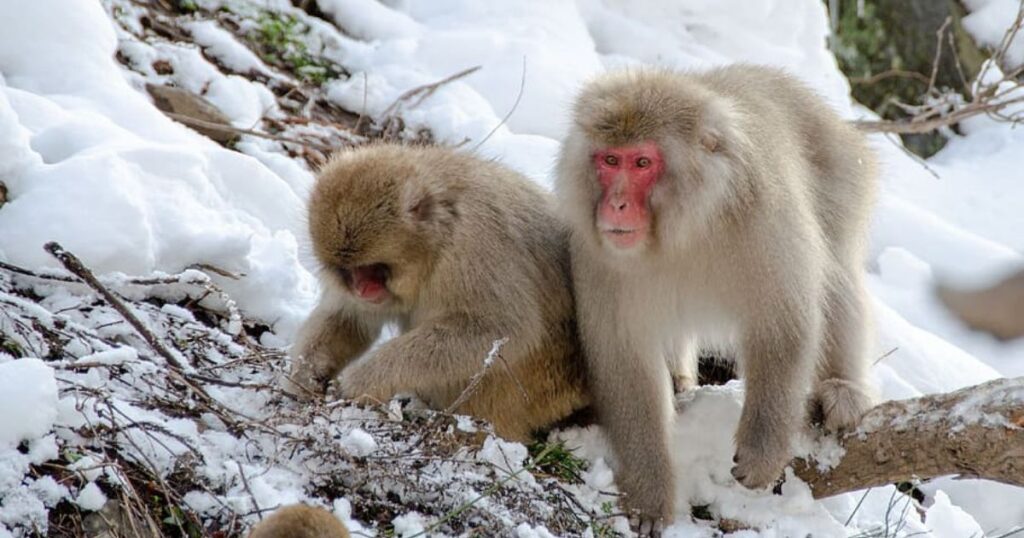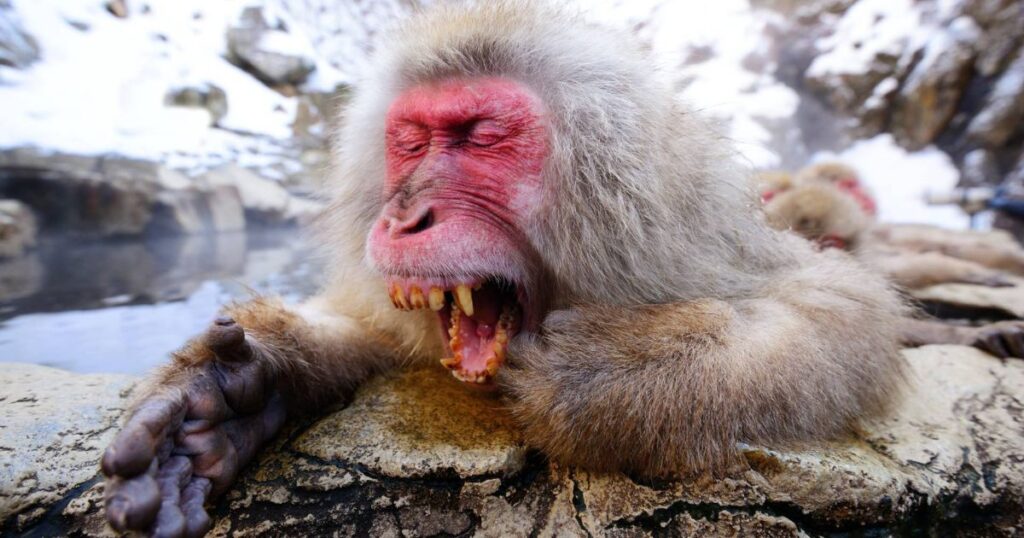Introduction
The Japanese macaque, also known as the snow monkey, is a fascinating primate species found in the islands of Japan. These hardy creatures have adapted to survive in some of the coldest environments inhabited by non-human primates. With their distinctive red-faced appearance and social behaviors, Japanese macaques have captivated the hearts of many wildlife enthusiasts worldwide.
Read More: Digital News Planet
Japanese Macaque: Size and Appearance
Japanese macaques boast a unique and striking appearance that sets them apart from their primate cousins. They are relatively sizeable, with an average height ranging from 50 to 90 centimeters (20 to 35 inches) when measured from head to rump. Adult males are typically larger than females, weighing 8 to 14 kilograms (18 to 31 pounds), while females weigh around 5 to 8 kilograms (11 to 18 pounds).
One of their most distinctive features is their reddish-pink faces, which become more vibrant during winter. This coloration is believed to help regulate body temperature by increasing blood flow to the face and extremities, keeping them warm in the cold Japanese winters. Their thick, furry coats also provide excellent insulation against the harsh weather conditions.

Habitat and Distribution
Japanese macaques are native to the islands of Japan and can be found in various habitats, from subtropical forests to temperate mountain regions. They have adapted remarkably well to diverse environments, including urban areas where they coexist with humans.
Their natural habitat ranges from the northernmost island of Hokkaido to the southern islands of Kyushu and Shikoku. They are particularly well-known for their ability to thrive in the snowy regions of Japan, such as the famous Jigokudani Monkey Park in Nagano Prefecture, where they can be observed bathing in natural hot springs during the winter months.

Population and Conservation
The population of Japanese macaques is currently classified as “Least Concern” by the International Union for Conservation of Nature (IUCN). While their numbers are stable in many parts of Japan, some local populations face threats from human activities, habitat loss, and fragmentation.
Conservation efforts have been implemented to protect these primates and their habitats. Japan has designated several national parks and protected areas where Japanese macaques can thrive without significant human interference. Public education and awareness campaigns have been instrumental in promoting coexistence between humans and these fascinating creatures.
Diet and Feeding Habits
Japanese macaques are omnivores, meaning they consume diverse plant and animal-based foods. Their diet consists primarily of leaves, fruits, seeds, bark, and various plant materials. They also consume insects, small mammals, bird eggs, and even small birds when possible.
One of their unique feeding strategies is their ability to forage for food in the snow. They have been observed using their hands to dig through the snow to uncover buried plants, roots, and other food sources. This adaptation allows them to survive where food is scarce during the harsh winter.
Behavior and Social Structure
Japanese macaques are highly social animals, living in hierarchical troops ranging from a few individuals to over a hundred monkeys. Their social behavior is complex, with dominant males and females maintaining order within the group.
Dominance hierarchies are established through various physical displays, such as staring contests, vocalizations, and occasional physical confrontations. These hierarchies determine access to resources, grooming partners, and breeding opportunities within the troop.
One of the most fascinating aspects of their behavior is their propensity for bathing in natural hot springs, a practice known as “monkey bathing.” This unique behavior helps them stay warm during winter and has become a significant tourist attraction in some areas of Japan.

Predators and Threats
While Japanese macaques have very few natural predators in their native environment, they face several threats from human activities. Habitat loss and fragmentation due to urbanization, deforestation, and agriculture pose significant challenges to their survival and well-being.
In some areas, conflicts with humans have arisen due to crop raiding or interactions in urban settings. These conflicts can sometimes lead to retaliatory actions, such as culling or relocating problematic individuals or troops.
Another potential threat comes from the increasing popularity of wildlife tourism in certain regions. Irresponsible interactions with tourists, such as feeding or attempting to touch the monkeys, can disrupt their natural behaviors and potentially transmit diseases.
Are Japanese Macaques Dangerous?
While Japanese macaques are generally not considered aggressive or dangerous towards humans, it is essential to maintain a respectful distance and avoid direct contact with them. Like wild animals, they can become defensive if threatened or provoked.
Feeding or attempting to approach these primates too closely can lead to bites, scratches, or other defensive behaviors. It is crucial to observe them from a safe distance and refrain from disturbing their natural activities or invading their personal space.
Responsible wildlife tourism practices and education are essential to minimize potential conflicts and ensure the safety of both humans and Japanese macaques.

Conservation Efforts and Ecotourism
Ecotourism has played a significant role in promoting the conservation of Japanese macaques and their habitats. By providing economic incentives for local communities to protect these primates and their natural environments, ecotourism has helped foster a sense of pride and ownership over these unique creatures.
Many national parks and wildlife sanctuaries in Japan offer guided tours and viewing opportunities for visitors to observe Japanese macaques in their natural habitats. These tours generate revenue for local communities and educate visitors about the importance of conserving these fascinating primates and their ecosystems.
Additionally, research and conservation organizations work tirelessly to study the behavior, ecology, and threats facing Japanese macaques. Their efforts contribute to developing effective conservation strategies and promote public awareness about the importance of protecting these remarkable animals.
Conclusion
The Japanese macaque is a remarkable primate species that has captured the imagination of people worldwide. Their unique adaptations to survive in harsh environments, complex social behaviors, and endearing appearance make them a fascinating subject of study and observation.
By promoting responsible ecotourism practices, supporting conservation efforts, and raising awareness about their challenges, we can ensure that these incredible creatures thrive in their natural habitats for generations.
FAQs:
1: What is unusual about the Japanese macaque?
Japanese macaques are known for being one of the few non-human primates that can survive in cold, snowy environments. Their ability to tolerate frigid temperatures and bathe in natural hot springs is unique.
2: What is the Japanese macaque famous for?
Japanese macaques are famous for bathing in natural hot springs during the winter months to keep warm, a behavior known as “monkey bathing.”
3: What do Japanese macaques eat?
Japanese macaques are omnivorous. Their diet includes plants like leaves, fruits, seeds, bark, insects, small mammals, bird eggs, and occasionally small birds.
4: How smart is a Japanese macaque?
Japanese macaques display advanced intelligence and complex social behaviors. They live in hierarchical troops with established dominance structures and have been observed using tools and problem-solving skills.
5: Which monkeys have a high IQ?
Some monkeys considered to have higher intelligence include chimpanzees, bonobos, orangutans, gorillas, and capuchin monkeys. These primates demonstrate impressive cognitive abilities.
6: What monkey had the highest IQ?
Chimpanzees are generally regarded as the most intelligent monkeys, with some even outperforming humans on specific memory tests. Their problem-solving and tool-using abilities are remarkable.
7: What is the #1 most intelligent animal?
While there is no definitive ranking, animals like elephants, dolphins, pigs, and certain primates like chimpanzees and orangutans are often considered among the most intelligent due to their cognitive abilities, memory, and problem-solving skills.
8: What are the most intelligent animals on Earth?
Some of the most intelligent animals on Earth include elephants, dolphins, whales, primates like chimpanzees and gorillas, pigs, parrots, octopuses, and certain corvid birds like crows and ravens.
9: Is a monkey smarter than an elephant?
In general, elephants are considered more intelligent than monkeys. Elephants have larger brains, display complex behaviors, have excellent memories, and can use tools and problem-solving.
10: What is the #1 most intelligent animal compared to humans?
There is no definitive #1 most intelligent animal compared to humans. However, chimpanzees and other great apes like bonobos, gorillas, and orangutans are often considered the closest in intelligence to humans due to their cognitive abilities and problem-solving skills.
11: What animal has the most minor brain?
Some animals with the most miniature brains relative to their body size include insects like fruit flies, ants, and bees. Their brains can be as small as a grain of rice or a pinhead.
12: How big is a whale’s brain?
The brain size of whales varies depending on the species. The sperm whale has one of the most giant brains among animals, weighing around 7-8 kilograms (15-18 pounds) on average.
13: Why is a sperm whale called a sperm whale?
Sperm whales are named after the waxy substance called spermaceti found in their heads. This substance was initially mistaken for sperm, hence the “sperm whale.”
14: How intelligent are killer whales?
Killer whales, orcas, are considered one of the most intelligent animals on Earth. They have large brains, engage in complex hunting strategies, communicate with various vocalizations, and display cultural traditions.
15: How big is a killer whale’s brain?
The brain of a killer whale can weigh around 6-7 kilograms (13-15 pounds), making it one of the giant brains among marine mammals and more significant than many terrestrial animals.





